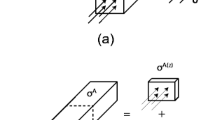Abstract
The paper describes destructive measurement of residual stress profiles across two perpendicular planes in a single coupon. Several established destructive measurement techniques can determine the residual stress locked in a coupon of interest, but in general, only a single measurement can be taken without releasing stress and affecting subsequent measurements. However, when the first measurement determines a stress profile across an entire plane, the released stress can be determined, through a supplemental stress analysis incorporating results from the first measurement, and then accounted for in a subsequent measurement. To demonstrate the capability, we describe measurements of residual stress profiles across two perpendicular planes in aluminum compact tension coupons. Residual stress was introduced into the coupons by laser shock peening, and measurements were performed using the slitting method. For each coupon, the measured stress profile on the first plane was used to compute stress released on the second plane. By adding this released stress to measured stress for the second plane, we obtain a stress profile for the second plane in the original configuration. Results of a numerical model that predicts residual stress due to laser shock peening are presented, and agreement between the model and experimental results gives confidence in the superposition method applied.










Similar content being viewed by others
References
Society for Experimental Mechanics (1996) In: Lu J (ed) Handbook of measurement of residual stresses. Fairmont, Lilburn
Hill MR, VanDalen JE (2008) Evaluation of residual stress corrections to fracture toughness values. J ASTM Int 5:11 pp
Fabbro R, Peyre P, Berthe L, Scherpereel X (1998) Physics and applications of laser-shock processing. J Laser Appl 10:265–279
Luong H, Hill MR (2008) The effects of laser peening on high-cycle fatigue in 7085-T7651 aluminum alloy. Mater Sci Eng 477:208–216
Luong H, Hill MR (2010) The effects of laser peening and shot peening on high cycle fatigue in 7050-T7451 aluminum alloy. Mater Sci Eng 527(3):699–707
Liu Q (2008) An effective life extension technology for 7xxx series aluminium alloys by laser shock peening: Final Report (DSTO-TR-2177). Defence Science and Technology Organisation, Fishermans Bend
DeWald AT, Hill MR (2009) Eigenstrain-based model for prediction of laser peening residual stresses in arbitrary three-dimensional bodies. Part 1: model description. J Strain Anal Eng Des 44(1):1–11
DeWald AT, Hill MR (2009) Eigenstrain-based model for prediction of laser peening residual stresses in arbitrary three-dimensional bodies. Part 2: model verification. J Strain Anal Eng Des 44(1):13–27
Achintha M, Nowell D (2011) Eigenstrain modeling of residual stresses generated by laser shock peening. J Mater Process Technol 211(6):1091–1101
Carr DG (2009) Institute of Materials Engineering, Australia Nuclear Science and Technology Organization, Private Communication
Pagliaro P, Prime MB, Robinson JS, Clausen B, Swenson H, Steinzig M, Zuccarello B (2011) Measuring inaccessible residual stresses using multiple methods and superposition. Exp Mech 51(7):1123–1134
Lee MJ, Hill MR (2007) Effect of strain gage length when determining residual stress by slitting. J Eng Mater Technol 129(1):143–150
Prime MB (1999) Residual stress measurement by successive extension of a slot: the crack compliance method. Appl Mech Rev 52(2):75–96
Cheng W, Finnie I, Gremaud M, Prime MB (1994) Measurement of near surface residual-stresses using electric-discharge wire machining. J Eng Mater Technol 116(1):1–7
Schajer GS, Prime MB (2006) Use of inverse solutions for residual stress measurement. J Eng Mater Technol 128(3):375–382
(2010) ABAQUS/Standard, version 6.10. SIMULIA, Inc., Providence, RI, USA
Author information
Authors and Affiliations
Corresponding author
Rights and permissions
About this article
Cite this article
Wong, W., Hill, M.R. Superposition and Destructive Residual Stress Measurements. Exp Mech 53, 339–344 (2013). https://doi.org/10.1007/s11340-012-9636-y
Received:
Accepted:
Published:
Issue Date:
DOI: https://doi.org/10.1007/s11340-012-9636-y




